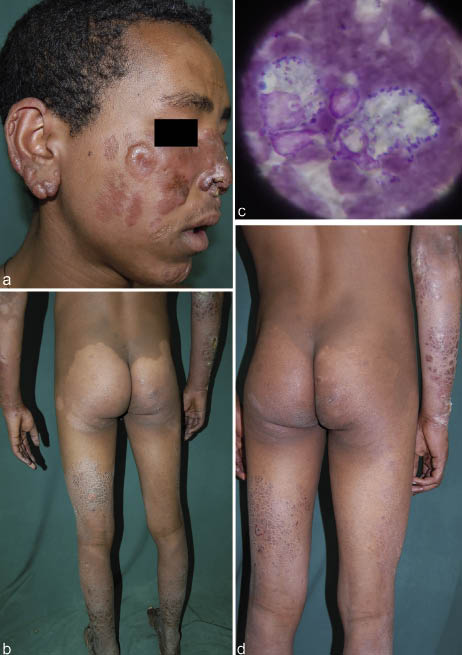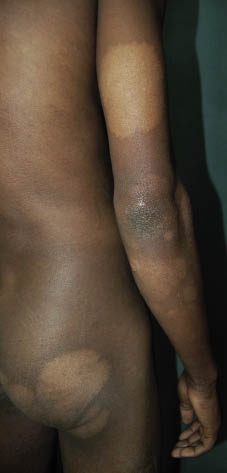Both cutaneous and mucocutaneous leishmaniasis are endemic in Northern Ethiopia. The different clinical presentations depend on the responsible organism and the host’s immune response. Localized cutaneous leishmaniasis is the type most frequently seen. Diffuse cutaneous leishmaniasis is relatively rare and usually associated with mucous membrane involvement. Diffuse cutaneous leishmaniasis presents with multiple lesions, can be difficult to diagnose and responds less favourably to treatment. We report here 2 patients with unusual presentations of diffuse cutaneous leishmaniasis presenting with large hypopigmented skin lesions mimicking borderline-tuberculoid leprosy. To our knowledge this presentation has not been described before and may present difficulties in making a definite diagnosis in regions where both leprosy and cutaneous leishmaniasis are endemic. Lepromatous leprosy and diffuse cutaneous leishmaniasis are regularly confused, particularly when no skin smears for acid-fast bacillus or Leishman-Donovan bodies are performed. Key words: leishmaniasis; leprosy; hypopigmentation.
Accepted December 6, 2011.
Acta Derm Venereol 2012; 92: XX–XX
Dr Federica Dassoni, Department of Dermatology, National Institute for Health, Migration and Poverty (NIHMP), IT-00153 Rome, Italy. E-mail: federica.dx@gmail.com
Cutaneous leishmaniasis (CL) is a disease caused by several different species of an intracellular protozoa belonging to the genus Leishmania, which is transmitted by the bite of a sandfly. It is endemic in 88 countries, including Ethiopia. CL has a wide clinical spectrum characterized by papules, nodules, ulcers and scarring (1–3). Clinical patterns tend to be poor indicators of the species responsible. Other factors, such as parasitic load and, particularly, the host immune response are the determining factors (4, 5).
Unusual presentations of CL occur and include:
- leishmaniasis recidivans, in which small nodules develop around a healed scar,
- angiolupoid cutaneous leishmaniasis of the face, resembling lupus erythematosus,
- mucocutaneous leishmaniasis (MCL), involving the mucosal membranes, and
- diffuse cutaneous leishmaniasis (DCL).
DCL is not common and usually presents with widespread nodules and plaques that do not ulcerate and the lesions contain high numbers of organisms. Patients with immunosuppression, and coexisting HIV infection, are particularly susceptible (6–8). Leishmaniasis and leprosy in all their manifestations are frequently diagnosed at the Italian Dermatologic Center of the Ayder Referral Hospital, Mekele in Tigray (Northern Ethiopia). Peripheral health workers often confuse lepromatous leprosy (LL) and DCL. Over a 6-year period, CL and MCL accounted for 1.74% (n = 1,146) of patients attending the department, while leprosy represented 0.70%. The localized cutaneous form of CL was most frequently encountered (86%), followed by MCL (11%), DCL (2.8%) and post-kala-azar dermal leishmaniasis (PKDL) (0.2%).
Most of the patients originated from the Mekele area and nearby villages in the Temben mountains. Leishmaniasis is endemic in the Tigrean highlands (> 2,000 m) (9, 10).
We report here two patients with an atypical presentation of DCL with large hypopigmented macules resembling those of borderline-tuberculoid leprosy. Both patients were farmers and came from the same village in the highlands near Mekele, an area characterized by a high incidence of CL and MCL. Visceral leishmaniasis (VL) is not reported from that area and they had not travelled into areas endemic for VL and were not related.
CASE REPORTS
Patient 1
An 18-year-old male presented with nodular erythematous lesions on his face (nose, ears, cheeks), hands and forearms, causing deformity of the nose (Fig. 1a), associated with multiple, large hypopigmented patches on the trunk, limbs and buttocks and some dry scaling on the lower limbs (Fig. 1b). The patches were bilateral, flat, dry and not infiltrated.
All the lesions were asymptomatic, had been present for over 4 years and were increasing in size and number. He was referred from a local health centre with the clinical diagnosis of leprosy. As the clinical presentation of the hypopigmented maculae was compatible with borderline leprosy, cutaneous sensation was checked in the hypopigmented areas and the peripheral nerves were carefully palpated for enlargement. No loss of sensation was found in the lesions and no abnormalities, enlargement, pain or tenderness were found at nerve palpation. There were no signs of neuropathy. The patient reported that the lesions appeared as hypopigmented patches from the beginning and there was no history of previous erythema or other signs of inflammation at the same site, which made post-inflammatory hypopigmentation unlikely. The patient was in good general health and there was no history of fever, hepatosplenomegaly, lymphoadenopathy or loss of weight and no history of previous therapy for visceral leishmaniasis. General clinical examination did not reveal any abnormalities. Routine blood examinations were normal, HIV test was negative. Slit-skin smears from the nodular lesions of the nose/ears were taken. Ziehl-Nielsen stain was negative for acid-fast bacilli, while Giemsa stain showed the presence of Leishmania amastigotes (Fig. 1c). To exclude the possibility of a co-existing leprosy/leishmaniasis infection, a punch biopsy was taken from a nodular and from a hypopigmented lesion. Histopathology from both lesions showed intense dermal inflammatory infiltration with plasma cells and lymphocytes, with the presence of Leishman bodies and no sign of nerve involvement or other signs of leprosy.
Meglumine antimoniate (Glucantime Sanofi) i.m. for 28 days was started with improvement of the nodular and hypopigmented lesions at follow-up (Fig. 1d). The patient subsequently received a second 28-day course of treatment, as DCL usually requires protracted antimonial therapy, because of the high risk of relapse, which makes complete healing difficult to achieve.
Fig. 1. Patient 1: Nodular erythematous lesions of the face (a). Hypopigmented dry lesions (b). Cytology from nodular lesions showing Leishmania amastigotes (Giemsa stain) (c). Partial repigmentation after treatment (d), (original magnification × 100).
Patient 2
A 20-year-old male patient, originating from the same area as the previous patient, presented with a 6-year history of multiple, bilateral, hypopigmented patches on his limbs and buttocks (Fig. 2). The patches were flat with no signs of infiltration, slightly dry, but asymptomatic. Small nodular and papular lesions were present on the fingers of both hands; there was nail dystrophy of the right big toe, and a few scars in the mandibular area.
Fig. 2. Hypopigmented patches in patient 2.
As the clinical picture was suggestive for borderline-leprosy, the hypopigmented lesions were tested for loss of cutaneous sensation. Sensation was normal and there was neither nerve enlargement nor signs of neuropathy. The patient’s general health was good and no fever, lymphadenopathy or hepatosplenomegaly were present. No previous history of treatment for leishmaniasis was noted. Routine blood examinations were normal, HIV test was negative. A punch biopsy was taken from a nodular lesion of the hands and one from a hypopigmented macule. Histology from both sites showed dermal infiltrate of epithelioid macrophages as well as macrophages with intracellular L. amastigotes. There were no signs of leprosy. The patient was treated with meglumine antimoniate like the previous patient, and initial improvement occurred from both nodular and hypopigmented lesions. He did not return for follow-up.
Discussion
Leishmaniasis is one of the top 5 diseases targeted by the World Health Organization (WHO) Special Program for Research and Training in Tropical Diseases. Approximately 1.5 million new cases are documented each year and more than 350 million people live in areas of active parasite transmission.
Clinically, localized cutaneous lesions may resemble other skin conditions; blastomycosis, sporotrichosis, cutaneous anthrax, eczema, fungal skin infections, lepromatous leprosy, Mycobacterium marinum infections, sarcoidosis, basal and squamous cell carcinomas, tuberculosis and infected insect bites. When the plaque lesions of CL are located on the face: systemic lupus erythematosus, discoid lupus erythematosus, sarcoidosis, lupus vulgaris, cutaneous lymphoma and erysipelas are in the differential diagnosis (2, 3, 11, 12).
In Ethiopia, cutaneous leishmaniasis is a widespread disease; it is caused mainly by L. aethiopica, which is almost always the causative agent in the highlands, but rarely by L. tropica and L. major, the latter two species being found in the lowland regions (13, 14).
Diffuse cutaneous leishmaniasis, in which a large number of lesions occur at several anatomically different sites, is usually secondary to an underlying deficiency in cell-mediated immunity. Several authors suggest that the dissemination of lesions in DCL is determined more by the immunogenetic background of the patient than by the virulence of the species involved (15–18).
Our experience in Northern Ethiopia is that skin lesions often resemble LL and slit skin smears are usually necessary to confirm the diagnosis leishmaniasis. Internal organ involvement is not seen and the disease responds only partially to treatment; relapses are frequent and the condition generally becomes chronic (19). Unlike in LL, nerve involvement does not occur.
The species involved in diffuse CL are L.(Viannia) braziliensis and L. amazonensis in the New World, and L. aethiopica in the Old World (15, 20). Diffuse CL may also be seen with other species when a HIV co-infection occurs (21). The two patients presented with multiple hypopigmented patches resembling borderline-tuberculoid leprosy are the first patients we have seen with this presentation in our hospital over a 6-year period and, to our knowledge, this picture has not yet been described elsewhere.
Hypopigmentation has also been observed by us in other patients affected by cutaneous leishmaniasis, but the lesions were different, usually infiltrated and surrounding nodular lesions as a halo of a few millimetres. Multiple hypopigmented macules are also a common feature in PKDL (5), but these are smaller and in greater numbers, and present mostly on the trunk and the proximal part of limbs. The 2 presented patients had neither a previous history of visceral leishmaniasis nor any systemic signs at presentation. In addition, their area of origin was not endemic for kala azar and they did not have a travel history to endemic areas. Both were negative for HIV. In both patients, clinical examination and biopsy confirmed that the lesions were not leprosy. Furthermore, the first patient, who attended the follow up and had received a full course of treatment with meglumine antimoniate (the only anti-leishmanial drug available in the region), showed an evident clinical improvement of the lesions after the treatment, with increased pigmentation of the patches (Fig. 1d).
In our experience these patients demonstrate a new clinical presentation of diffuse cutaneous leishmaniasis, the mechanism causing hypopigmentation being unknown, but could possibly be due to a new parasite strain or to a specific environmental factor. The two patients originated from the same area and were not related. An explanation for the hypopigmentation might be an autoimmune process influencing the pigment formation, as occurs in leprosy and PKDL (22). Further studies should be focused on characterizing the species in patients who present with this unusual clinical feature, knowing L. aethiopica to be the species most often isolated in the Ethiopian highlands, according to other studies (13, 14). However, this type of research is difficult in areas where there are no specialized laboratories available that can culture or use molecular techniques for typing the infecting organism.
Meanwhile, as Tigray Region is endemic for both leishmaniasis (9, 10) and leprosy, DCL as well as leprosy should be included in the differential diagnosis of hypopigmented lesions.
ACKNOWLEDGEMENTS
Dr Victoria M. Yates for her comments, suggestions and language review.
REFERENCES





